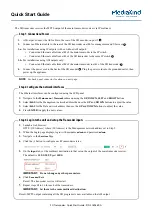
MFJ-9412 Instruction Manual
12-Meter SSB Transceiver
6
TWELVE-METER ANTENNA SYSTEMS
The better your antenna system works, the more you'll enjoy using the MFJ-9412. Here
are some general tips for getting top performance:
•
Antenna Selection:
Dipoles, ground-planes, and converted CB antennas all provide
good performance for casual operation. However, for serious DX hunting, a compact
3-element yagi or 2-element quad will yield significantly better results. Many
compact directional antennas are small and light enough to roof-mount on a standard
TV rotor using readily-available TV hardware. If possible, avoid using low-efficiency
"compromise" antennas. Never operate into an antenna with unknown or high VSWR.
•
Making a Dipole:
A simple 12-meter dipole cut for 24.93 MHz will be
approximately 18' 9-1/2" long. To prevent feedline radiation and reduce unwanted
noise pickup, make a simple choke balun at the center by coiling up a short length of
the coax and securing it with electrical tape or tie-wraps.
18' 9-1/2"
Choke Balun: 4-5 feet of feedline
coiled in 6-8 turns.
•
Antenna Location:
Mount your antenna as high and in-the-clear as possible, but
remember to factor in feedline loss. A chimney-mounted antenna at 40' with a short
low-loss feedline may actually out-perform one mounted 20' higher with a long lossy
feed. Be sure to isolate your antenna from other larger antennas or RF-reflective
metallic surfaces that may distort its normal radiation pattern.
•
Coax Cable:
For runs to 60', RG8X (or mini-8) works well at 24.9-MHz. For longer
runs, or when running a high-power amplifier, use larger-diameter low-loss cable such
as RG8 foam or RG213. Seal all exterior connectors against moisture with silicon
grease, rubber tape, or premium-quality electrical tape.
•
Rotor:
Many TV-type rotors will handle a short-boom 12-meter Moxon, beam, or
quad antenna. However, long-boom or stacked arrays will require a heavier rotor
designed especially for amateur radio use.
•
Safety Tips:
When installing antennas, make sure someone is available to assist you
in an emergency. Also, avoid any location where your antenna could fall and contact
power wires. For catastrophic lightening protection, permanently ground the mast and
coax shield
outside
the building with a good ground rod system. Also, remember to
disconnect the feedline from your radio at the first sign of severe weather. Even
nearby strikes may damage sensitive receiver components with the antenna connected.






























